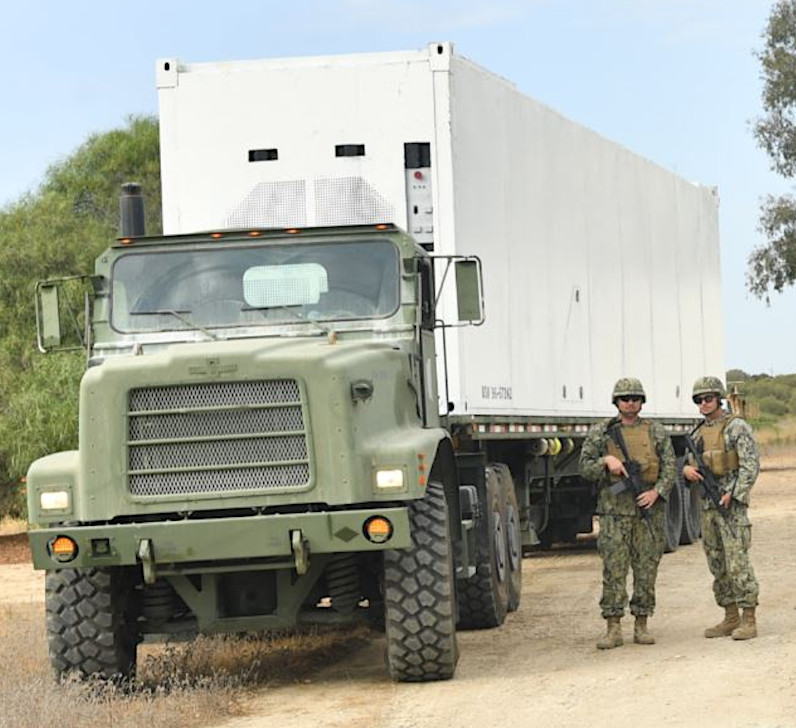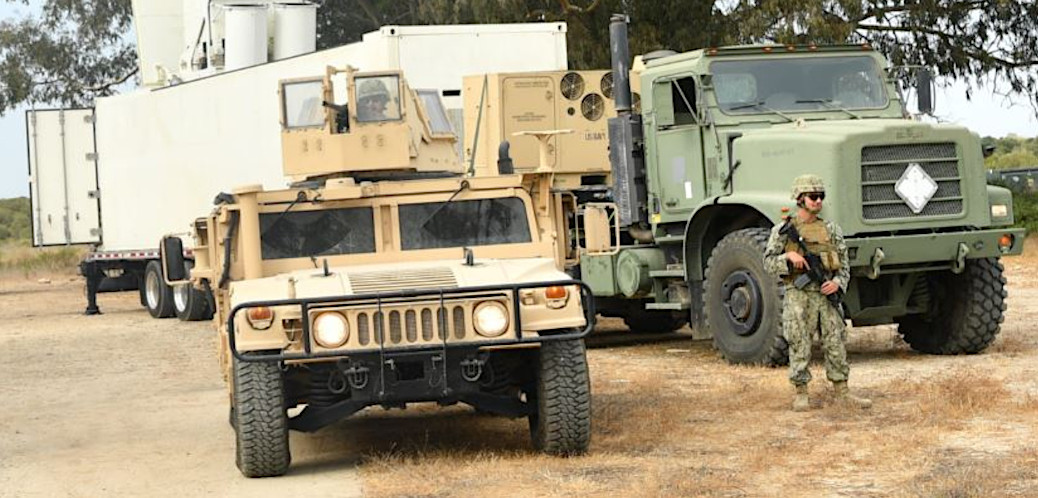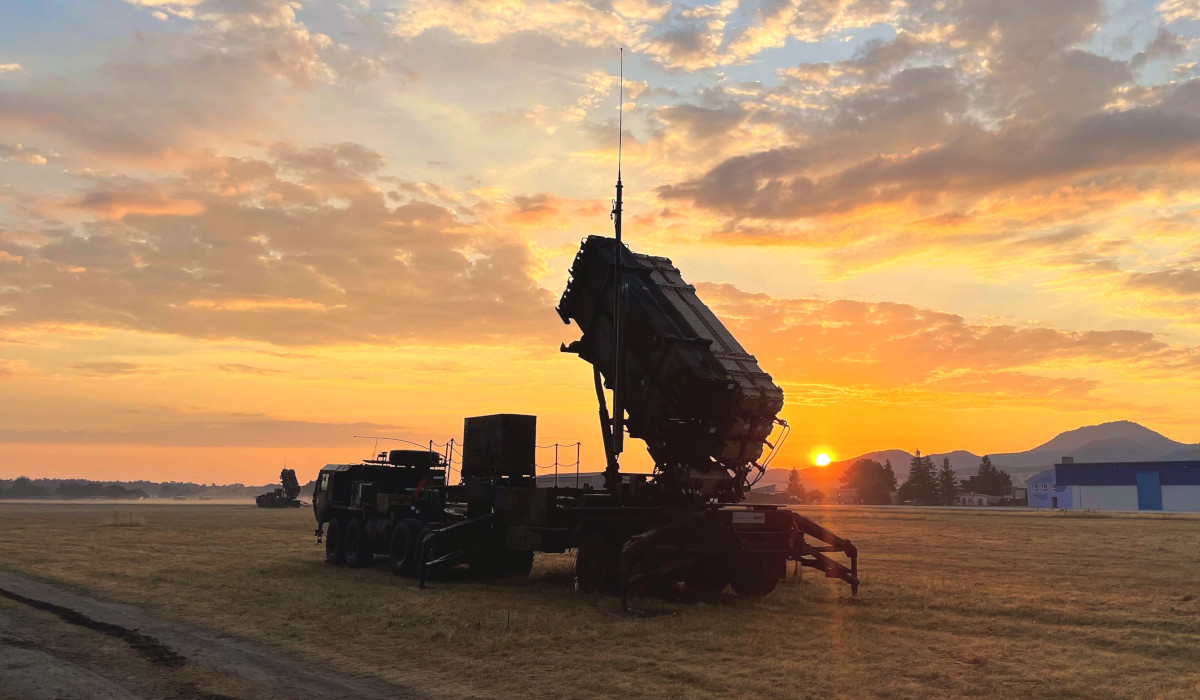The U.S. Navy has revealed that it recently demonstrated a road-mobile ground-based launching system for multi-purpose SM-6 missiles at an as-yet undisclosed location in Europe. The containerized launcher module, in this case loaded onto a tractor-trailer, is all but certainly the same type, or a variant thereof, as the one that was installed on the unmanned test ship Ranger for a live-fire test last year. This launcher system is also set to be a component of the U.S. Army’s future Typhon system, which is expected to be able to fire SM-6s, as well as Tomahawk land-attack cruise missiles.
Photographs of what the Navy described as a “modular SM-6 launcher system” appeared on official social media accounts belonging to the service’s Naval Forces Europe-Africa/U.S. Sixth Fleet (NAVFOREUR-AF/Sixth Fleet) earlier today.
“U.S. Naval Forces Europe-Africa/U.S. Sixth Fleet personnel conducted convoy protection rehearsals with a U.S. Navy modular SM-6 launcher system within the U.S. European Command (EUCOM) area of responsibility on Sunday,” according to the post on NAVFOREUR-AF/Sixth Fleet’s Facebook page. “This U.S. Navy capability enables rapid defense of the maritime domain.”
At the time of writing, there do not appear to be any further details from the Navy regarding this event or the system itself. The War Zone has reached out to NAVFOREUR-AF/Sixth Fleet for more information.
As already noted, the launcher seen in the pictures released by NAVFOREUR-AF/Sixth Fleet looks to be the same as the one that the Pentagon’s Strategic Capabilities Office (SCO) used to test launch an SM-6 from Ranger last year, or at least be an extremely closely related variant for ground-based use. The launcher employed on Ranger has also been referred to as the Mk 70 Mod 1 Expeditionary Launcher. Ranger was originally acquired as part of SCO’s Ghost Fleet Overlord program, but has since been transferred to the Navy, as you can read more about here.

The launcher installed on Ranger was itself an evolution of a trailer-mounted Lockheed Martin system, also referred to as the Payload Deployment System (PDS), derived from the Mk 41 Vertical Launch System used on various Navy and foreign warships. SCO had used in a live-fire test of a Tomahawk land-attack cruise missile in 2019. That test launch had occurred shortly after the collapse of the Intermediate-Range Nuclear Forces Treaty, or INF, between the United States and Russia. The INF had banned both countries from developing and fielding any conventional and nuclear-armed land-based missile systems with maximum ranges between 300 and 3,400 miles.

The photographs that NAVFOREUR-AF/Sixth Fleet put out show a second tractor trailer with what could be another launch module container. The trailer is different and the tractor lacks the generator behind the cab seen on the one attached to the deployed launcher. It is not clear whether each launch module needs its own generator, or if multiple launchers could be connected to a single power source.



It’s worth noting that previously released artwork depicting the complete components of the Army’s future Typhon system also included a trailer-mounted containerized battery operations center (BOC), along with ones carrying launcher modules and additional canisterized missiles. The service has also said Typhon will be employed only for surface-to-surface strikes, at least initially. Given the modular, multi-purpose nature of the launcher, it seems possible, if not probable that this will change as time goes.

Regardless of the exact configuration of the complete system the Navy has now demonstrated in Europe, or the specific circumstances behind that event, this reflects a significant new development in post-INF U.S. military ground-based missile capabilities. It is immediately notable since before now there were no indications that the service was itself interested in a shore-based missile system. This could, of course, have been a joint service demonstration or part of work related to the Army’s Typhon system or similar efforts that the Marine Corps is pursuing.
No matter what, a road-mobile, ground-based launch system for SM-6 presents an immensely flexible multi-purpose system that can be used in defensive roles, as NAVFOREUR/Sixth Fleet said was the focus of this recent demonstration in Europe, as well as offensive ones. Existing variants of the SM-6 family of missiles are already capable of engaging a variety of aerial threats, including traditional ballistic missiles and more novel hypersonic weapons in the terminal stages of their flights, as well as targets at sea or ashore. A new version with greatly expanded capabilities, including a higher, likely hypersonic peak speed and greater range, is now in development.
The SM-6 has a demonstrated ability to be cued to targets by offboard sensors that the launching platform may not itself be able to detect or track, as well.

Containerized components only add to the flexibility this system could offer. This could allow it to be emplaced at a fixed location, if desired, or potentially employed in more novel ways, such as while lashed to the top deck of a Navy amphibious warfare ship.
In addition, the underlying Mk 70 Mod 1 launcher has been used to fire the Tomahawk, versions of which now have increasing anti-ship, as well as land-attack capabilities. Since it is derived from the Mk 41 VLS, it should be to fire a wide array of other existing and future missiles, as well.
Altogether, the system could provide a valuable and readily deployable anti-access/area denial node that could be used to deter potential adversaries, as well as engage hostile forces in actual conflict. The Navy’s recent demonstration of this particular ground-based missile system in Europe comes amid the U.S. military’s ongoing efforts, together with other NATO members, to bolster the alliance’s posture along its eastern peripheries to help deter further Russian aggression in light of the current conflict in Ukraine.

The Army and Marine Corps are interested acquiring in new, more capable ground-based missile systems for exactly these reasons. These kinds of capabilities are particularly important to the future concepts of operation that the Marine Corps is in the process of refining now. The service is currently focused on a future vision that centers on disturbed and expeditionary operations involving forces with signifiant long-range strike and other capabilities that can be relatively rapidly deployed and redeployed within a theater, as you can read more about here.
It’s also worth noting that the U.S. Missile Defense Agency (MDA) has been exploring new mobile missile defense concepts, particularly as part of work to expand anti-missile capabilities on Guam. Especially with SM-6’s existing missile defense role, a road-mobile launch system like the one NAVFOREUR-AF/Sixth Fleet has now shown in Europe could certainly be part of that equation in the future.
Some members of Congress have also been separately pushing the Navy to at least explore the possibility of integrating Mk 70 Mod 1 launchers on Independence or Freedom class Littoral Combat Ships (LCS) as a way to quickly expand the capabilities of those vessels.
With all this in mind, it will certainly be interesting to learn more about the Navy’s recent work with its new ground-based missile system in Europe. What is clear is that the U.S. military as a whole is continuing to make important progress in expanding its ground-based long-range missile capabilities.
Update 9/15/22:
The War Zone has now received a response from U.S. Naval Forces Europe-Africa/U.S. Sixth Fleet to our queries for more information about this recent demonstration.
“As with all pieces of military equipment, the U.S. Navy regularly conducts training on all systems in order to ensure maximum readiness to defend ourselves, allies, and partners,” Navy Lt. Cmdr. Karl Schonberg, a NAVFOREUR-AF/Sixth Fleet spokesperson, said in a statement. “Rehearsals such as this contribute to U.S. Naval Forces Europe’s ability to be ready anywhere at any time should the need arise.”
“The modular SM-6 launcher system dramatically increases the U.S. Navy’s flexibility to move and employ the launcher in the best interests of the United States and our allies and partners,” Schonberg added. “At this time, we cannot speak to the operational scope of the modular SM-6 launcher in the European theater.”
Contact the author: joe@thedrive.com
